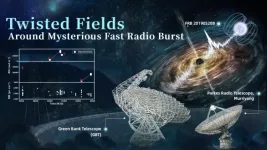(Press-News.org) LA JOLLA, CA— Scripps Research chemists have solved a long-standing problem in the field of pharmaceutical chemistry with a relatively simple and controllable method for making benzocyclobutenes (BCBs)—a class of reactive compounds that are highly valued as building blocks for drug molecules, but have been relatively hard to access.
The new method, described in a paper in Science on May 12, uses designer ligand molecules with palladium-atom catalysts to break pairs of adjacent methylene-type C-H bonds in relatively cheap and abundant carboxylic acids. Breaking these bonds enables the making of BCBs with unprecedented ease through a process called a formal [2+2] cycloaddition.
The researchers demonstrated the new method with relatively easy syntheses of several BCBs found in traditional medicines and in experimental and approved drug molecules
“Our new method requires only a saturated aliphatic chain and aryl halides as coupling partners for a formal cycloaddition yielding a four-membered ring,” says study senior author Jin-Quan Yu, PhD, the Bristol Myers Squibb Endowed Chair in Chemistry and Frank and Bertha Hupp Professor in the Department of Chemistry at Scripps Research. “By contrast, the traditional method for making BCBs requires more steps and yields a mix of products that are hard to separate.”
BCBs have a unique core structure consisting of a relatively rigid, strained and reactive ring of four carbon atoms fused to a benzene ring. They are present in some natural medicinal compounds and in the heart-failure drug ivabradine. In general, their propensity for biological activity makes them potentially very useful building blocks for drugs. They are also key ingredients in photosensitive polymers, polymer dielectrics and other advanced materials.
The synthesis of BCBs has been challenging, however. The limitations of the various methods that have been published include an inability to control the order in which individual reactions occur, so that the reaction products include not only the desired product but also unwanted ones. Yu’s new method for the first time enables this control—a property called regioselectivity.
Last year, the Yu lab developed a method for the palladium-catalyzed, β- and γ-methylene C-H functionalization of free aliphatic acids, to make structurally diverse γ- and δ-lactones—also highly valued as potential pharmaceutical building blocks. Inspired by that method and using it as a starting point, they pursued a similar approach to surmount the challenge of BCB regioselective synthesis.
For the new method, they employed bidentate amide-pyridone ligands bearing palladium catalysts to activate the C-H bonds of two adjacent methylene units in a carboxylic acid.
“In the presence of a dihaloheteroarene, two C–H bonds and two aryl–halogen bonds are stitched together almost miraculously to form a bicyclic BCB scaffold,” Yu says. “Regioselectivity is achieved through the differentiation between the aryl iodide and bromide sites.”
The chemists showed that the method can be used with a wide range of cyclic and acyclic aliphatic acids to generate diverse BCBs and hetero-BCBs—a dream come true for many pharmaceutical chemists.
“The ability to make direct use of abundant and structurally varied acyclic and cyclic acids as substrates, without pre-functionalization, substantially expands chemists’ access to diverse BCB scaffolds—including heterocyclic BCBs that can be very useful in drug molecules,” Yu says.
“Regio-controllable [2+2] benzannulation with two adjacent C(sp3)–H bonds” was co-authored by Ji-Min Yang, Yu-Kun Lin, Tao Sheng, Liang Hu, Xin-Pei Cai and Jin-Quan Yu, all of Scripps Research.
Support for the research was provided by the National Institute of General Medical Sciences (2R01GM084019).
About Scripps Research
Scripps Research is an independent, nonprofit biomedical institute ranked one of the most influential in the world for its impact on innovation by Nature Index. We are advancing human health through profound discoveries that address pressing medical concerns around the globe. Our drug discovery and development division, Calibr, works hand-in-hand with scientists across disciplines to bring new medicines to patients as quickly and efficiently as possible, while teams at Scripps Research Translational Institute harness genomics, digital medicine and cutting-edge informatics to understand individual health and render more effective healthcare. Scripps Research also trains the next generation of leading scientists at our Skaggs Graduate School, consistently named among the top 10 US programs for chemistry and biological sciences. Learn more at www.scripps.edu.
END
A better route to benzocyclobutenes, sought-after buildingblocks for drugs
Scripps Research chemists devise a new, C-H activation-based method for the synthesis of BCBs.
2023-05-11
ELSE PRESS RELEASES FROM THIS DATE:
Researchers discover twisted fields around mysterious fast radio burst
2023-05-11
Fast Radio Bursts (FRBs) are the brightest millisecond-duration cosmic explosions in radio bands. Their unknown origin poses challenges for astronomy as well as physics.
The Commensal Radio Astronomy FAST Survey (CRAFTS), a key program of the Five-hundred-meter Spherical radio Telescope (FAST), discovered the world's first persistently active repeating FRB, known as FRB 20190520B. Now this FRB has provided clues that may help clarify the origin of FRBs.
An international team led by Dr. LI Di from the National Astronomical Observatories of the Chinese Academy of Sciences (NAOC) carried out a monitoring campaign of FRB 20190520B, using the Parkes telescope in Australia and ...
U.S. Fishing Policy is Boosting Fish Populations, Not Constraining Most Fisheries
2023-05-11
Commercial fishing employs 1.2 million Americans and generates more than $165 billion annually. Yet warming waters are threatening fish populations and disrupting fisheries around the world—a challenge set to worsen as climate change advances. Despite the importance of sustaining fisheries, the reauthorization of the cornerstone policy protecting them in the United States—the Magnuson-Stevens Act—has been stalled in Congress for a decade. The holdup? Some blame the policy for being too stringent and leading to what they call “underfishing,” while others ...
Human ancestors preferred mosaic landscapes and high ecosystem diversity
2023-05-11
A new study published in the journal Science by an international team finds that early human species adapted to mosaic landscapes and diverse food resources, which would have increased our ancestor’s resilience to past shifts in climate.
Our genus Homo evolved over the past 3 million years – a period of increasing warm/cold climate fluctuations. How early human species have adapted to the intensification of climate extremes, ice ages, and large-scale shifts in landscapes and vegetation remains elusive. ...
Hammerhead sharks hold their breath on deep water hunts to stay warm
2023-05-11
Scalloped hammerhead sharks hold their breath to keep their bodies warm during deep dives into cold water where they hunt prey such as deep sea squids. This discovery, published today in Science by University of Hawai‘i at Mānoa researchers, provides important new insights into the physiology and ecology of a species that serves as an important link between the deep and shallow water habitats.
“This was a complete surprise!” said Mark Royer, lead author and researcher with the Shark Research Group at the Hawai‘i Institute of Marine Biology (HIMB) in the UH Mānoa School of ...
The feeling of hunger itself may slow aging in flies
2023-05-11
From low-carb to intermittent fasting, surgery to Ozempic—people turn to a seemingly never-ending array of diets, procedures and drugs to lose weight. While it has been long understood that limiting the amount of food eaten can promote healthy aging in a wide range of animals, including humans, a new study from University of Michigan has revealed that the feeling of hunger itself may be enough to slow aging.
Previous research has demonstrated that even the taste and smell of food can reverse the beneficial, life-extending effects of diet restriction, even without its consumption.
These intriguing findings drove first author Kristy Weaver, Ph.D., principal investigator ...
Nature is changing as land abandonment increases
2023-05-11
When people leave their rural lives behind to seek their fortunes in the city or agriculture is no longer profitable, the lands they toiled on are often left unused. A new perspective piece in Science shows that these abandoned lands could be both an opportunity and a threat for biodiversity, and highlights why abandoned lands are critical in the assessment of global restoration and conservation targets.
The past 50 years have seen an increased exodus of populations from rural to urban areas. Today, 55% ...
First-of-its-kind measurement of the Universe’s expansion rate weighs in on a longstanding debate in physics and astronomy
2023-05-11
Thanks to data from a magnified, multiply imaged supernova, a team led by University of Minnesota Twin Cities researchers has successfully used a first-of-its-kind technique to measure the expansion rate of the Universe. Their data provide insight into a longstanding debate in the field and could help scientists more accurately determine the Universe’s age and better understand the cosmos.
The work is divided into two papers, respectively published in Science, one of the world’s top peer-reviewed academic journals, and The Astrophysical Journal, a peer-reviewed scientific journal of astrophysics and astronomy.
In astronomy, there are two precise ...
Historic achievement for international penile cancer trial--100 patients enrolled thus far, the most ever to a prospective study for treatment of an extremely rare disease
2023-05-11
Cancer of the penis is not a subject that comes up in conversation. When it does, one common response is, “I didn’t know you could get cancer there.” Not only is it not spoken about, but it is also rare, with fewer than one case per 100,000 men diagnosed in developed countries like the United States and the United Kingdom per year. That rarity has meant far fewer clinical trials have been developed and conducted to guide its treatment, and in most cases, only small numbers of patients have been included. Fortunately, researchers from both sides ...
Getting active, while living with a partial spinal cord injury
2023-05-11
A UBC Okanagan researcher has been testing the effectiveness of a mobile app that encourages people living with a spinal cord injury—but can walk—to get active.
Dr. Sarah Lawrason, a researcher in the School of Health and Exercise Sciences, has focused her career on working with people who live with a spinal cord injury (SCI) but are ambulatory. She describes this population as an isolated, often misunderstood group of people because while they live with an SCI, they may not rely on a wheelchair all of the time for mobility.
“When people think of someone with an SCI, they picture a ...
New, free online language course helps you learn Ojibwe
2023-05-11
TORONTO – May 11, 2023 – With funding from Canada’s Social Sciences and Humanities Research Council (SSHRC), Baycrest, the Kingston Indigenous Language Nest (KILN) and the University of Toronto have released a free online language course to learn the Indigenous language Ojibwe, also known as Anishinaabemowin.
The Ojibwe language is spoken in Indigenous communities around the Great Lakes in Canada and the US, but serious efforts are needed to ensure the long-term survival of the language.
“Due to the aging of people who ...
LAST 30 PRESS RELEASES:
Heart-brain connection: international study reveals the role of the vagus nerve in keeping the heart young
Researchers identify Rb1 as a predictive biomarker for a new therapeutic strategy in some breast cancers
Survey reveals ethical gaps slowing AI adoption in pediatric surgery
Stimulant ADHD medications work differently than thought
AI overestimates how smart people are, according to HSE economists
HSE researchers create genome-wide map of quadruplexes
Scientists boost cell "powerhouses" to burn more calories
Automatic label checking: The missing step in making reliable medical AI
Low daily alcohol intake linked to 50% heightened mouth cancer risk in India
American Meteorological Society announces Rick Spinrad as 2026 President-Elect
Biomass-based carbon capture spotlighted in newly released global climate webinar recording
Illuminating invisible nano pollutants: advanced bioimaging tracks the full journey of emerging nanoscale contaminants in living systems
How does age affect recovery from spinal cord injury?
Novel AI tool offers prognosis for patients with head and neck cancer
Fathers’ microplastic exposure tied to their children’s metabolic problems
Research validates laboratory model for studying high-grade serous ovarian cancer
SIR 2026 delivers transformative breakthroughs in minimally invasive medicine to improve patient care
Stem Cell Reports most downloaded papers of 2025 highlight the breadth and impact of stem cell research
Oxford-led study estimates NHS spends around 3% of its primary and secondary care budget on the health impacts of heat and cold in England
A researcher’s long quest leads to a smart composite breakthrough
Urban wild bees act as “microbial sensors” of city health.
New study finds where you live affects recovery after a hip fracture
Forecasting the impact of fully automated vehicle adoption on US road traffic injuries
Alcohol-related hospitalizations from 2016 to 2022
Semaglutide and hospitalizations in patients with obesity and established cardiovascular disease
Researchers ‘listen in’ to embryo-mother interactions during implantation using a culture system replicating the womb lining
How changing your diet could help save the world
How to make AI truly scalable and reliable for real-time traffic assignment?
Beyond fragmented markets: A new framework for efficient and stable ride-pooling
Can shape priors make road perception more reliable for autonomous driving?
[Press-News.org] A better route to benzocyclobutenes, sought-after buildingblocks for drugsScripps Research chemists devise a new, C-H activation-based method for the synthesis of BCBs.





